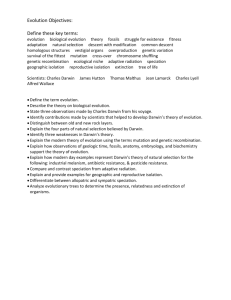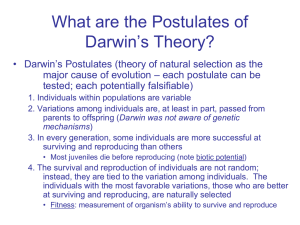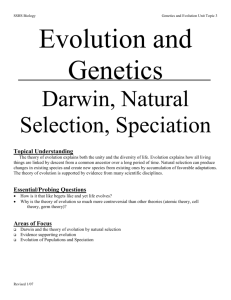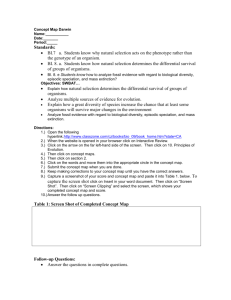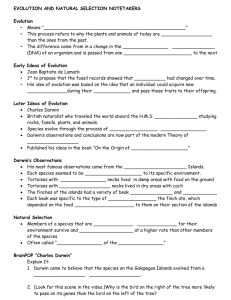Chapter 4: Evolution and Extinction
advertisement
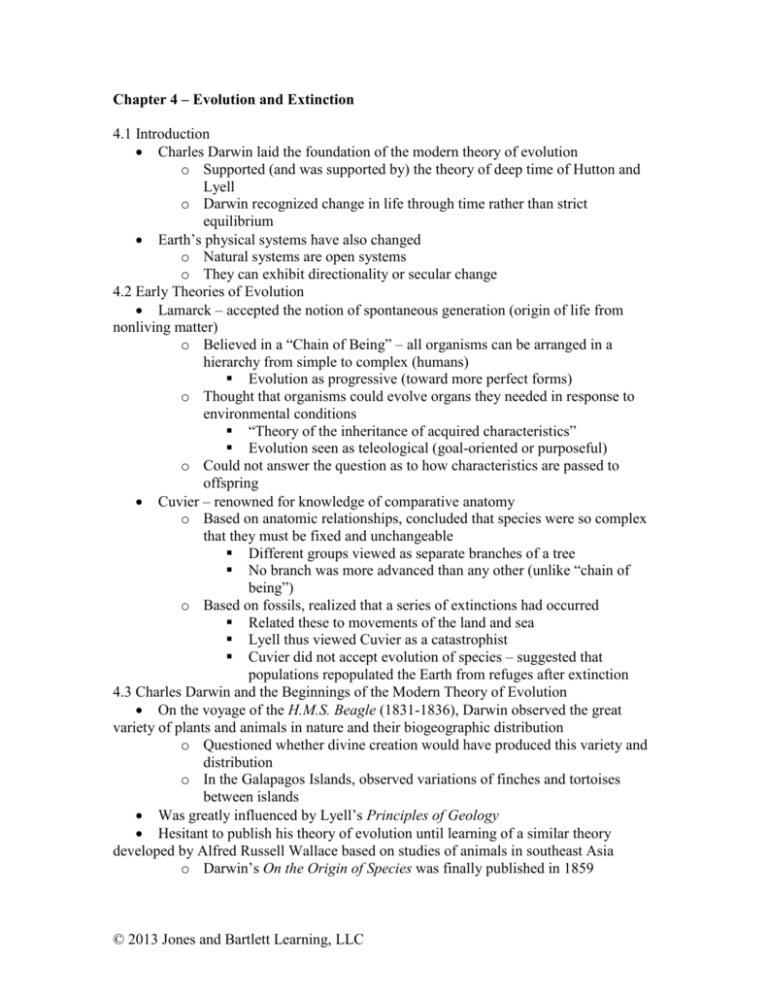
Chapter 4 – Evolution and Extinction 4.1 Introduction Charles Darwin laid the foundation of the modern theory of evolution o Supported (and was supported by) the theory of deep time of Hutton and Lyell o Darwin recognized change in life through time rather than strict equilibrium Earth’s physical systems have also changed o Natural systems are open systems o They can exhibit directionality or secular change 4.2 Early Theories of Evolution Lamarck – accepted the notion of spontaneous generation (origin of life from nonliving matter) o Believed in a “Chain of Being” – all organisms can be arranged in a hierarchy from simple to complex (humans) Evolution as progressive (toward more perfect forms) o Thought that organisms could evolve organs they needed in response to environmental conditions “Theory of the inheritance of acquired characteristics” Evolution seen as teleological (goal-oriented or purposeful) o Could not answer the question as to how characteristics are passed to offspring Cuvier – renowned for knowledge of comparative anatomy o Based on anatomic relationships, concluded that species were so complex that they must be fixed and unchangeable Different groups viewed as separate branches of a tree No branch was more advanced than any other (unlike “chain of being”) o Based on fossils, realized that a series of extinctions had occurred Related these to movements of the land and sea Lyell thus viewed Cuvier as a catastrophist Cuvier did not accept evolution of species – suggested that populations repopulated the Earth from refuges after extinction 4.3 Charles Darwin and the Beginnings of the Modern Theory of Evolution On the voyage of the H.M.S. Beagle (1831-1836), Darwin observed the great variety of plants and animals in nature and their biogeographic distribution o Questioned whether divine creation would have produced this variety and distribution o In the Galapagos Islands, observed variations of finches and tortoises between islands Was greatly influenced by Lyell’s Principles of Geology Hesitant to publish his theory of evolution until learning of a similar theory developed by Alfred Russell Wallace based on studies of animals in southeast Asia o Darwin’s On the Origin of Species was finally published in 1859 © 2013 Jones and Bartlett Learning, LLC o Refrained from addressing human evolution (later included in The Descent of Man) 4.4 Basic Premises of Darwinian Evolution Darwin reasoned that tiny differences occurred in the natural variations of organisms o These variations could be passed from one generation to the next Plant and animal populations do not grow unchecked o A “struggle for existence” eliminates unfit individuals (those with less suitable variations) Darwin called this “natural selection” based on the artificial selection used by plant and animal breeders Differential reproduction occurs – survivors live long enough to breed and pass on favorable traits to offspring o Thus there is descent with modification, and there is natural selection for more fit individuals over long intervals of time o Natural selection acts as negative feedback on unfit individuals (and as positive feedback on more fit ones) Natural selection could account for trends seen in the fossil record o Similar to Lyell’s view of slow, gradual change o However, results in directional change (initially rejected by Lyell) 4.5 Inheritance and Variation Darwin explained inheritance through his theory of “pangenesis” o He suggested that each organ of an individual’s body develops particles he called “gemmules” o Gemmules could take on characteristics in the manner Lamarck had described o Each offspring would be a blend of gemmules from both parents Gregor Mendel discovered the true basic mechanism of inheritance o A monk who tended the monastery garden, Mendel conducted experiments in which he crossed varieties of peas o He concluded that genetic traits occur in pairs (alleles), which behaved like particles o His theory is known as the particulate theory of inheritance o Mendel published the work in an obscure journal (and sent a copy to Darwin, which he apparently never read); Later work revealed the existence of chromosomes o Mendel’s work was rediscovered and its significance for heredity realized o Genetic recombination produced the variety on which natural selection could act 4.6 Genetic Code and Mutation Breeding experiments established that changes in certain portions of chromosomes corresponded to alterations in traits o Thus, variation also resulted from mutations (changes to genes) o Mutations are now recognized as producing the “raw material” for natural selection DNA (deoxyribonucleic acid) was recognized to serve as the hereditary code © 2013 Jones and Bartlett Learning, LLC o Molecular structure of DNA was determined by Watson and Crick (1950s) Natural selection acts on mutations, coupled with genetic recombination, to produce evolutionary change that results in new species 4.7 Evidence for Natural Selection Since Darwin’s time a number of well-documented cases of natural selection have helped to substantiate his theory o Industrial melanism – soot-blackened trees led to the darkening of moths; with the decline of coal use, the original coloration has returned o Other examples are related to the role of medicine and agriculture in society 4.8 Speciation Mutations are spread through populations through interbreeding o Speciation could occur through geographic isolation of populations that prevents interbreeding (allopatric speciation) o Another mechanism of speciation is genetic drift, which involves some genetic traits being lost simply by chance, whereas others are passed on o Populations that have partly diverged (but not developed into full-fledged species) are called subspecies 4.9 Evolution and the Fossil Record Comparative Anatomy o Homologous structures (common evolutionary ancestry but dissimilar function) – evolved for different functions (divergent evolution) o Analogous structures (similar function but dissimilar structure) – arise through similar selective pressures (convergent evolution) Cladistics o Classifies taxa according to whether or not they share the same traits o Shared traits indicate common ancestry, indicated in a cladogram o Traits are considered to be primitive (appearing first) or derived (appearing later in succession) Microevolution o Involves slow, gradual processes o Thought to result from short-term genetic processes like those documented in genetic experiments and biogeographic studies of species distribution o The resulting pattern was called phyletic gradualism o Was thought to produce pseudoextinction of species (anagenesis, the gradual transition of one species to another) o Lack of observed transitions was dismissed as an artifact of the geologic record (due to nonpreservation or erosion) o Punctuated equilibrium arose as an alternative mode of speciation; argued that long intervals of slow, nondirectional change were punctuated by the abrupt appearance of new species o Punctuated equilibrium is basically a record of allopatric speciation preserved in the fossil record Macroevolution o New species (or taxa at higher categories) may eolve because of rapid genetic change in small populations © 2013 Jones and Bartlett Learning, LLC o The modern synthesis (post-WWII) coupled Darwinian evolution with modern genetics; it dismissed macroevolution based on genetic experiments on human time scales o Haeckel’s biogenetic law (“ontogeny recapitulates phylogeny”) states that an individual’s development reflects its evolutionary history o Scientists recently discovered regulatory genes called Homeobox (“Hox”) genes that control the early development of certain body regions o Rapid evolution of new structures and possibly whole new taxa may take place through mutations in these master control genes (Hox genes) 4.10 Mass Extinction Extinction is normal and has occurred through geologic time as a kind of background extinction o 99.9% of all species that have ever existed have become extinct Many species may die out when the biosphere is decimated by global cooling, massive volcanism, decreased oxygen in the ocean, and meteor impacts o Such events are mass extinctions Mass extinctions may have acted to increase Earth’s biodiversity by creating new evolutionary opportunities o New species evolving to fill the niches of previously existing species is called ecologic replacement o Ecologic replacement occurring among a particular taxon is an adaptive radiation The survival of a species during a mass extinction depends on its tolerance to environmental change o Eurytopic species are more likely to survive than stenotopic ones After extinction (during the recovery phase), any and all mechanisms of microevolution and macroevolution may give rise to new taxa through adaptive radiation 4.11 Biodiversity Through the Phanerozoic The fossil record reflects major changes in the evolution of marine and terrestrial communities through the Phanerozoic o Three evolutionary faunas can be recognized: the Cambrian Fauna, the Paleozoic Fauna, and the Modern Fauna o Biodiversity appears to have increased through the Phanerozoic © 2013 Jones and Bartlett Learning, LLC


